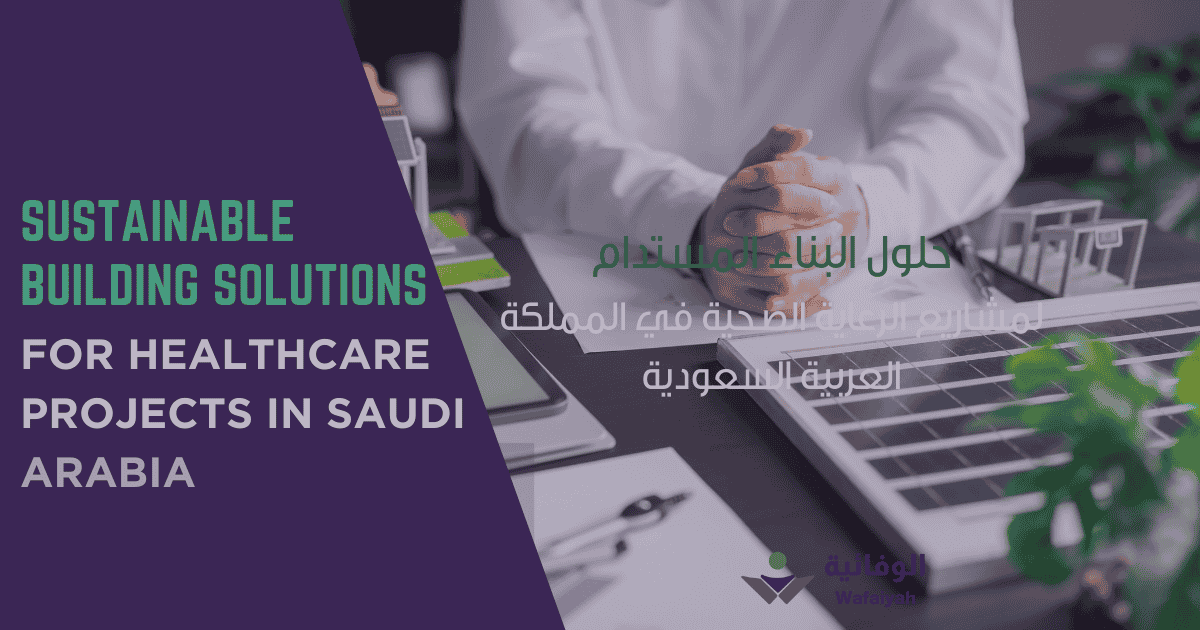Saudi Arabia’s healthcare sector is growing rapidly as part of Saudi Vision 2030, aiming to provide excellent medical services for all. Alongside this expansion, sustainability in construction has become a key priority, especially for healthcare facilities. Sustainable healthcare buildings matter because they reduce environmental impact, improve the well-being of patients and staff, and deliver long-term cost savings. Wafaiyah sees this as an opportunity to create lasting value. This article shares practical, clear ideas for applying sustainable building solutions in Saudi healthcare projects, ensuring they meet both today’s needs and tomorrow’s responsibilities.
Sustainability is a significant challenge for hospital buildings in harsh climates. Hospitals are one of the most sensitive facilities due to high cooling loads, limited water and constant 24/7 operation. In Saudi Arabia, all these requirements put pressure on the environment and on the operating budgets. To reduce energy consumption, reduce carbon emissions, and save water. It is necessary to align hospital infrastructure with Vision 2030 and the Saudi Green Initiative. The design of eco-friendly hospitals improves the level of indoor comfort, reduces running expenses, and enhances the well-being of patients and employees. Smart cooling, excellent energy management, and water recycling are a few major green solutions that balance the environment with performance. Eco-friendly building practices can help healthcare providers provide a healthier environment with better results.
Key Sustainable Building Principles for Healthcare
Highlighted below are the key sustainable building principles for the hospital sector:
- Energy Efficiency
- Water Conservation
- Indoor Environmental Quality
- Material Sustainability
Let’s explain each principle in detail below:
Energy Performance
LED lighting, advanced cooling, and automated controls can save energy without compromising patient care. Through HVAC systems and integrating renewable energy, such as solar, the costs can be reduced. It also reduces carbon emissions, which keeps facilities reliable, resilient, and in line with national sustainability objectives.
Water Conservation
Hospitals must be the first example in areas where water is scarce. Smart irrigation, low-flow fixtures, and greywater recycling consume less water without impacting hygiene. Smart monitoring systems help in identifying leaks early so that every drop is utilized carefully. This protects resources, responds to community needs, and fulfils environmental commitments without affecting health services.
Indoor Environmental Quality
The indoor environment in a hospital influences recovery and well-being. Fresh air, exposure to daylight, and noise control features make healthier, quieter patient and staff environments. Sound-absorbing materials, low-emission finishes, and proper ventilation contribute to the prevention of illness and healing. This makes sustainability a source of both environmental and health performance.
Material Sustainability
The use of eco-friendly materials will reduce the environmental impact of a building and will keep the economy in the area. Long-lasting, low-VOC materials ensure better air quality, and locally produced ones reduce the number of emissions during transportation. Recycled materials will guarantee long-term performance and environmental responsibility. It is a strategy that has achieved a balance between safety, quality, and sustainability in all aspects of the construction of the hospital.
Sustainable Design Strategies for Healthcare Projects
Passive Design Approaches
Introducing passive design solutions in the hospital building can also reduce energy consumption before the installation of any systems. Locate buildings in ways that do not expose them to direct sunlight. Install shades and reflective surfaces to keep the interiors cool. Design natural airflow so that patients and staff will enjoy the fresh and comfortable air.
Energy-Efficient Systems
Use LED lighting that has smart controls to dim down when there is natural light. Select efficient heating, cooling and ventilation systems. Connect all to a Building Management System to monitor performance and easily identify any energy-wasting areas.
Use Renewable Energy
Solar photovoltaic panels can generate electricity in hospitals. Solar thermal systems can heat water. Medical campuses on a significant scale can also integrate renewable sources into hybrid systems. This will provide a constant supply of eco-friendly energy for key operations.
Water-Saving Technologies
Water performance helps with cost saving and environmental objectives. Greywater can be recycled to use as irrigation water or flush toilets. Low-flow fixtures save on wastage without compromising on comfort. Smart irrigation systems keep track of soil conditions and weather conditions so that landscaping remains healthy and consumes the minimum amount of water.
Indoor Environment Planning
A healthy indoor environment will facilitate quick recovery and employee well-being. HEPA filtration improves the quality of air by eliminating toxic particles. Glazing and large windows allow daylight to enter the building, improving the mood and decreasing the necessity to use artificial light. The acoustic design makes spaces quieter, reduces stress, and enhances concentration.
Sustainable Construction Materials and Methods for Saudi Hospitals
Sustainable construction for hospitals in Saudi Arabia focuses on using materials and methods that save energy, reduce waste, and protect the environment. Local stone, recycled steel, and low-emission concrete help lower the carbon footprint while supporting the local economy. Advanced insulation and smart glass improve energy efficiency, keeping buildings cooler and reducing air-conditioning costs. Water-saving plumbing systems and harvesting rainwater are vital in the region’s dry climate. Solar panels and energy-efficient lighting further cut operational costs and emissions. Using modular construction methods speeds up building time and reduces site waste, ensuring minimal disruption to patient care. By combining these practices, Saudi hospitals can create healthier spaces, lower long-term costs, and meet global sustainability goals, while delivering safe and comfortable care for patients and staff.
Significant Challenges & How to Overcome Them
Major challenges in the green hospital projects usually begin with the high upfront costs. This can be better handled with a long-term payoff on investment in a precise lifecycle analysis. The gaps in technical expertise can be addressed through specific training in sustainable healthcare design. Regulatory and certification procedures, including LEED or Mostadam in Saudi Arabia, need to be adequately planned and guided by professionals to make sure that they are followed. Lastly, it is essential to manage change in operations. Involve employees in such initiatives to bring about powerful results. Strategically addressing these issues can help to gain better environmental and economic advantages.
Future Trends in Sustainable Healthcare Building in Saudi Arabia
Sustainable and patient-centred hospital buildings are gaining popularity in Saudi Arabia in the future. Net-zero energy hospitals will reduce their carbon footprint and cut down long-term expenses. Digital twin technology and AI will improve the performance of buildings. Biophilic design and vertical gardens will make spaces healthier. They will promote patient recovery and staff wellness. Hybrid and off-grid power will bring reliable hospitals to remote and rural regions, lessening reliance on traditional grids. Such trends are in line with the Vision 2030 of Saudi Arabia. They will build modern facilities that protect the environment, improve patient experience and community health for future generations.
Conclusion
Sustainable healthcare buildings play a vital role in protecting health, saving resources, and creating better patient environments. They align perfectly with Saudi Vision 2030’s goals for both healthcare and environmental progress. Achieving this requires architects, engineers, and policymakers to work hand in hand. At Wafaiyah, we believe sustainable hospitals are not just a trend, but a responsibility to future generations. By acting today, we can build facilities that heal people and respect our planet for years to come.
Frequently Asked Questions
What is the importance of sustainability in hospital buildings?
Since hospitals use a lot of energy and water, sustainable design saves on operating expenses and environmental effects and enhances patient care.
Which are the best renewable energy sources for Saudi hospitals?
The Kingdom has high solar irradiation, making solar PV and solar thermal systems very effective.
Does sustainable building raise the cost of hospital buildings?
The initial costs may be higher, but the energy, water, and maintenance costs can be saved in the long term, which is usually more than the initial costs.
Is it possible to retrofit current hospitals in Saudi Arabia to be sustainable?
Retrofits may involve LED lighting, water-efficient fixtures, improved insulation, and renewable energy systems.

